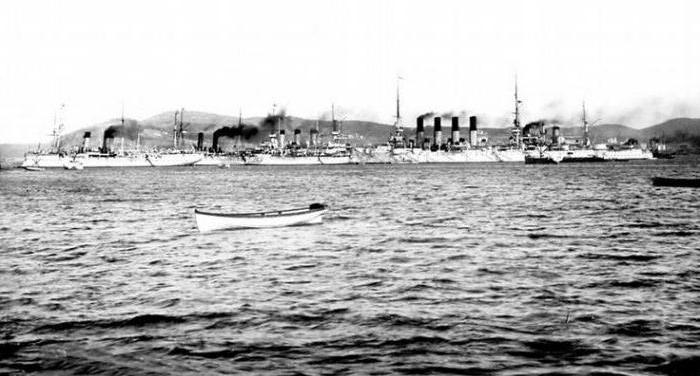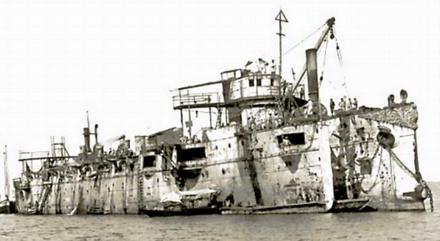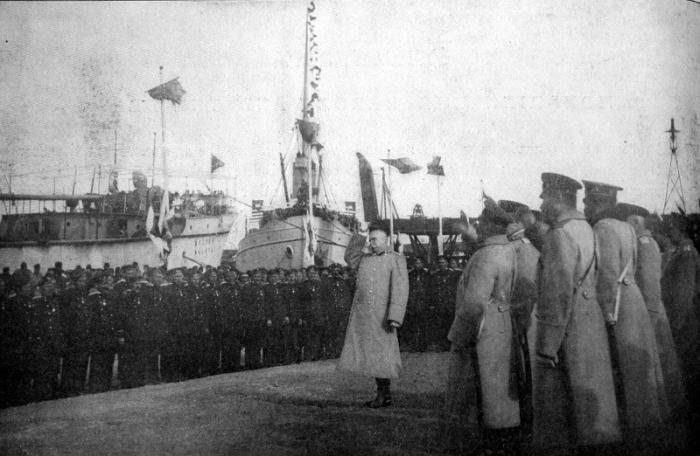The cruiser "Varangian" was built in 1899. The ship became part of the Pacific Flotilla. On the eve of the Russo-Japanese War, the Varangian went to the neutral Korean port of Chemulpo (modern Incheon). Here he was at the disposal of the Russian embassy. The second such vessel was the gunboat “Koreets”.
On the eve of the battle
On the eve of the new 1904, Captain Vsevolod Rudnev received a secret encryption. It was reported that the Korean emperor learned about the movement of ten Japanese ships in the direction of Chemulpo (the death of the cruiser "Varyag" occurred at one time in the bay of this port). So far, there has been no war, although both countries have been actively preparing for it. In Russia, Japan was looked down upon, because of which the army and navy were in a difficult position when the conflict broke out for real.
The Japanese flotilla was commanded by Admiral Sotokichi Uriu. His ships arrived on the coast of Korea to cover the landing. The flotilla was supposed to stop the "Varangian" if he decided to leave the bay and intervene in the transfer of the army. On January 27 (old style), enemy ships appeared in the coastal waters. It was the first day of the Russo-Japanese war.
The situation in the port of Chemulpo was complicated due to the fact that there were vessels from other countries: Great Britain, France, Italy and the USA. On the morning of January 27, the Japanese admiral Uriu sent a message to their representatives that he was going to attack Russian ships. In this regard, neutral ships were invited to leave the raid before 16 hours, so that they did not come under fire. The Europeans informed Captain Rudnev of the Japanese warning. It became clear that the battle was inevitable, despite a clear violation of international law (the drama broke out in the port of a third country).
The approach of the Japanese flotilla
By morning, the landing of the three thousandth contingent was already completed. Now transport ships left the battlefield, and warships could begin preparations for the upcoming attack. The port saw a fire at the landing site of the Japanese. The enemy deliberately psychologically pressured the Russian sailors. The heroic death of the cruiser Varyag showed that all these attempts were doomed to failure. The Russian sailors and their officers were ready for anything, although they had to humiliatingly wait for the enemy attack and helplessly watch the landing.
Meanwhile, the commanders of foreign ships sent a written protest to the Japanese. This paper has no effect. The foreigners did not dare to take any other steps. Their ships retired to the port and did not show themselves during the battle. The Russian cruiser and gunboat were blocked in the bay. They could not go into the open sea, since the Japanese flotilla of ten ships blocked the road. The subsequent death of the Varyag cruiser occurred largely due to paralysis and inept command actions in Port Arthur. The fleet leaders behaved irresponsibly. They did not try to prevent the disaster, although reports of the approach of the Japanese squadron have been received for months.
"Varangian" leaves Chemulpo
Captain Vsevolod Rudnev, realizing that waiting for help from foreigners or his own superiors is pointless, decided to break out of the bay and accept the battle. There was simply no question of surrender. At 10 am, the captain arrived on the cruiser and informed the officers of his decision. The general opinion was unanimous - to try to break through, and if the attempt fails, then flood the ships.

The first to start the battle were the doctors. Doctors, nurses and paramedics equipped dressing stations. For the next few days, they forgot what sleep is — they had too much work. At 11 o’clock Rudnev delivered a speech to the whole team. The sailors supported the captain with the loud “Hurray!” No one was afraid of the death of the Varyag cruiser, no one wanted to give up, folding their hands in advance. The reaction to the Korean was similar. Even the cook, who was a civilian worker, refused to leave the ship and take refuge in the consulate. When the Varangian left the port, foreign crews lined up on the decks of their ships. So the French, Italians and British paid tribute to the courage of the crew, who had an unequal battle ahead. In response to the Varangian, national anthems of these countries were played.
Aspect ratio
Which squadron was supposed to withstand the cruiser "Varyag"? The history of the ship’s death might not have happened at all, had it fought in other conditions of warfare. Each Japanese ship was within his power. The exception was the Asama, one of the best armored cruisers in the world. "Varangian" was the embodiment of the idea of a strong and high-speed reconnaissance. Its main advantage in the battle was a rapid raid and a short but deafening blow to the enemy.
“Varyag” could best demonstrate all these qualities in the open sea, where he would have room for maneuver. But its location, and subsequently the place of death of the cruiser "Varyag" was in a narrow channel full of shallows and stones. In such conditions, the ship could not accelerate and effectively hit the enemy. Due to the narrow course, the cruiser had to go on the fly with the Japanese. Therefore, the outcome of the battle was determined only by the ratio of the number of guns. A dozen ships had much more than a cruiser with a gunboat.
The situation became especially hopeless due to the presence of Asama. The guns of this cruiser were practically invulnerable, as they were hiding behind thick tower armor. For comparison: on Russian ships, artillery was open and decked. In addition, half of the "Korean" guns were simply outdated. During the battle, they were generally inactive.
The beginning of the battle
Japanese ships determined the place of death of the cruiser "Varyag", standing ten miles from the Korean Chemulpo. When the squadrons met, there was a signal asking for surrender. "Varangian" proudly said nothing about this proposal. The first shots from Asama sounded about 12 hours. They were produced at the moment when the ships were at a distance of about 8 kilometers from each other.
Everyone understood that the death of the Varyag cruiser was inevitable. The battle, however, was accepted. Two minutes after the first Japanese shots, gunfire began on the starboard side of the Varyag. It was led by Kuzma Khvatkov - senior commander. On the eve of the battle, he was in the infirmary after the operation. Upon learning of the upcoming battle, the commandant demanded discharge and soon arrived aboard the Varyag. Khvatkov with rare courage continued to shoot continuously throughout the battle, even after all his assistants were killed and wounded.
The first hit, a Japanese shell destroyed the upper nose bridge and killed the focus guys. Because of this, a fire broke out in the navigational cabin. An explosion followed, killing the junior navigator Alexei Nirod and the signalman Gavriil Mironov. The extinguishing of the fire was led by Timothy Shlykov - a bold and decisive boatswain.
Fire on board
Pillars of black smoke were the first signs that marked the death of the cruiser "Varyag". The date of January 27, 1905 was the day of courage and persistence of the Russian crew. The fire allowed the Japanese to easily adjust the fire on the enemy. The Varyag’s guns were aimed mainly at Asamu. The fire was fired by armor-piercing shells that really tore apart the thick armor and exploded inside the ship. Therefore, the damage caused to the Japanese was not as obvious as the fire on the Russian cruiser.
The Asama cruiser was distracting. He distracted the attention of the "Varyag" cannons, thanks to which other ships of the Japanese flotilla could shoot the enemy with impunity. Shells began to hit the target more and more often. So, the death of the cruiser "Varangian" was gradually approaching. Photos of the heroic crew and his ship soon hit all the world's newspapers.
But on the afternoon of January 27, sailors and officers were clearly not up to the future. After the next hit, the deck deck caught fire. The fire became extremely dangerous, because there was a signaling system nearby, as well as elevators. They tried to bring down the flames with powerful jets of water supplied from hoses. Meanwhile, the gunners standing at the open guns fell dead due to a deadly whirlwind of fragments raised by enemy shells.
Doctors worked intently and silently. The flow of the wounded increased. People who received severe injuries found the strength to get to the infirmary on their own. Lightly wounded did not pay attention to the damage at all and remained at their posts. So heroic and unprecedented was the death of the cruiser "Varyag". Both the gunboat and the main ship happened to be under heavy fire of the enemy, reveling in his numerical superiority.
Maneuver
When the "Varangian" was eight miles away from Chemulpo, the captain decided to turn to the right to get out of the fire and bring into battle the guns on the port side. The ship began to maneuver, and at that moment the ship was hit by two large shells. The heroic death of the cruiser "Varyag" has become even closer. Due to the explosion, the ship lost steering. Some of the fragments fell straight into the wheelhouse, where, in addition to the captain, there were some officers and musicians. The drummer and the staff horn died, many were injured, but no one wanted to go to the infirmary and leave Rudnev.
Due to the loss of the steering wheel, an order was given to switch to manual control. Nobody wanted the death of the cruiser “Varangian” to be easily given to the enemy. The Russo-Japanese War had just begun, and there were still many similar battles ahead, when Russian ships were in a numerical minority. Their crews, following the crew of the Varyag, showed miracles of courage and devotion to their duty.

The cruiser crept up to the enemy flotilla five miles away. The fire of the Japanese intensified. It was at this time that the "Varangian" received the most severe and fatal injuries. A large-caliber shell pierced the stern on the port side. Water poured into the holes, which began to flood the stoker with coal. The quartermasters Zhigarev and Zhuravlev rushed into the room. They prevented the further spread of water and the flooding of other fireplaces with it. Over and over, the death of the cruiser Varyag was postponed. In short, the Russian crew struggled with the stubbornness that only doomed people have driven into a corner.
Retreat
Meanwhile, the “Korean” began to cover up the “Varangian”, who made an important maneuver. His small shells finally got the opportunity to reach the enemy ships. Reciprocal shooting began. Soon, a fire broke out on one of the Japanese cruisers, and another destroyer completely began to sink. When the turn was completed, guns on the port side joined the battle. The commandos - the main characters of the battle, furious with the death of their comrades, fired without stopping. The result was not long in coming. One of the shells destroyed the stern bridge of Asama, the best Japanese cruiser. The author of the successful shot was the commandant Fedor Elizarov, who was standing behind the six-inch gun number 12.
After the turn, the captain sent the ship back to the raid, trying to postpone the death of the Varyag cruiser. The date of this event has become one of the most striking and tragic in the history of the Russian fleet. By 13 o’clock the battle ceased, since the Varangian was finally back on the raid.
During the battle, he released more than 1,100 shells. The crew lost half the crew on the upper deck. Fans and boats were turned into a sieve. The deck and sides received numerous holes, which is why the "Varyag" appeared roll to the left side.
Cruiser flooding
The foreign ships, which had previously been on the roadstead, prepared to leave for the port so as not to interfere with the Japanese ending the Russians. Rudnev, assessing the situation, realized that the cruiser had lost most of its combat power. In such circumstances, the fight was impossible. At a short military council, the captain decided to open the kingstones and flood the ship.
The evacuation of the team began. The wounded sailors and officers passed each other in their arms. The death of the Varyag cruiser and the Korean boat was approaching. Most of the Russians moved to neutral ships. The last crew members remaining on the ship to flood it remained in the water. Someone got to the ships by swimming, and Vasily Belousov remained holding on to the ice floe awaiting the arrival of a French boat.

The "Korean" was blown up. Foreigners asked to do without such a measure in relation to the cruiser. The fact was that the wreckage of the gunboat at great speed collided with the water surface near the neutral ships. Roll "Varyag" became stronger. From a distance, new explosions were periodically heard on it - this fire consumed the surviving cartridges and shells. Finally, the ship sank. At 18 o'clock the final death of the cruiser Varyag was noted. The image of the ship, which entered into battle with unequal forces, and its heroic crew forever remained in the memory of the Russian fleet.
The return of the crew to their homeland
23 people died in the battle, another 10 seriously wounded died in hospitals after evacuation. The remaining crew went to their homeland in mid-February. The heroic death of the cruiser Varyag and the gunboat Koreets has already become known to the whole world. Sailors and officers in every country where they stayed were greeted with cordiality and undisguised admiration. From all corners telegrams and letters were sent to them.
A large delegation of compatriots met the crew in Shanghai, where the gunboat Manjur was then located. The Consul General and the Ambassador of Russia in Constantinople rushed to meet with the heroes, despite their very short stop in this city. Glory was ahead of sailors. The crew was supposed to return to their homeland, landed in Odessa. In this city for several weeks preparations were underway for his meeting.

Right on board the steamboat arrived, the heroes were awarded the St. George Crosses. It should be said that all crew members were awarded, regardless of rank. A salute was given in honor of the arrivals. The whole city was choked with festive glee. A similar picture was in Sevastopol, where the Black Sea Fleet was based. On April 10, 1904, 600 sailors and 30 officers of the "Varyag" and "Korean" went to St. Petersburg with a special echelon. On the way, the train stopped in Moscow and at several other stations. Everywhere invariably the train was waiting for the townspeople and the first persons of the cities.
On the 16th, the crew finally ended up in St. Petersburg. On the platform of the Nikolaevsky station he was met by relatives, representatives of the City Duma, the army, the nobility and, of course, all the highest ranks of the Russian fleet. At the head of this crowd was the admiral-general, Grand Duke Alexei Alexandrovich.
The sailors marched on the festively decorated Nevsky Prospect. The street was packed full of city dwellers. Along the entire avenue, soldiers lined the metropolitan garrison, who were supposed to restrain the crowd. The solemn orchestra was not heard against the background of incessant screams and applause. The culmination was the meeting of the crew and Tsar Nicholas II.
The fate of the ship
The Japanese were amazed at the behavior and courage of the Russians. It is significant that the emperor Mutsuito in 1907 sent captain Vsevolod Rudnev the Order of the Rising Sun of the II degree. The death of the cruiser "Varangian" from year to year was remembered not only in Russia but also in Japan. In Tokyo, they decided to raise and repair the cruiser. He was included in the Imperial fleet and received the name "Soy". For seven years it was used as a training vessel. The name "Varangian" at the stern of the ship was saved by the Japanese as a sign of respect for the courage of Russian sailors and officers. Once the cruiser even went camping in the Hawaiian Islands.

With the outbreak of World War I, Russia and Japan became allies. The tsarist government bought the Varyag back. In 1916, he returned to Vladivostok under the Russian flag. The ship was transferred to the flotilla of the Arctic Ocean. On the eve of the February Revolution, the cruiser went to the UK for repairs. The authorities of this country confiscated the "Varangian" when the Bolsheviks refused to pay the debts of the tsarist government. In 1920, the ship was sold to the Germans for scrap. In 1925, the cruiser fell into a storm during towing and finally sank in the Irish Sea.